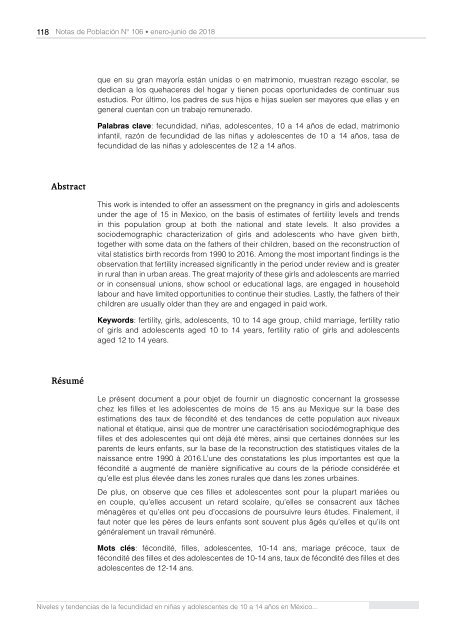Notas de Población N° 106
El número 106 de Notas de Población está conformado por 10 artículos, en cuya elaboración han participado 21 colaboradores. Los artículos abordan diversos temas de investigación relacionados con la mortalidad, el transnacionalismo migratorio y la fecundidad de las migrantes, así como la fecundidad adolescente, el femicidio, la migración de retorno, la segregación en el espacio urbano y el dividendo demográfico.
El número 106 de Notas de Población está conformado por 10 artículos, en cuya elaboración han participado 21 colaboradores. Los artículos abordan diversos temas de investigación relacionados con la mortalidad, el transnacionalismo migratorio y la fecundidad de las migrantes, así como la fecundidad adolescente, el femicidio, la migración de retorno, la segregación en el espacio urbano y el dividendo demográfico.
Create successful ePaper yourself
Turn your PDF publications into a flip-book with our unique Google optimized e-Paper software.
118<br />
<strong>Notas</strong> <strong>de</strong> <strong>Población</strong> <strong>N°</strong> <strong>106</strong> • enero-junio <strong>de</strong> 2018<br />
que en su gran mayoría están unidas o en matrimonio, muestran rezago escolar, se<br />
<strong>de</strong>dican a los quehaceres <strong>de</strong>l hogar y tienen pocas oportunida<strong>de</strong>s <strong>de</strong> continuar sus<br />
estudios. Por último, los padres <strong>de</strong> sus hijos e hijas suelen ser mayores que ellas y en<br />
general cuentan con un trabajo remunerado.<br />
Palabras clave: fecundidad, niñas, adolescentes, 10 a 14 años <strong>de</strong> edad, matrimonio<br />
infantil, razón <strong>de</strong> fecundidad <strong>de</strong> las niñas y adolescentes <strong>de</strong> 10 a 14 años, tasa <strong>de</strong><br />
fecundidad <strong>de</strong> las niñas y adolescentes <strong>de</strong> 12 a 14 años.<br />
Abstract<br />
This work is inten<strong>de</strong>d to offer an assessment on the pregnancy in girls and adolescents<br />
un<strong>de</strong>r the age of 15 in Mexico, on the basis of estimates of fertility levels and trends<br />
in this population group at both the national and state levels. It also provi<strong>de</strong>s a<br />
socio<strong>de</strong>mographic characterization of girls and adolescents who have given birth,<br />
together with some data on the fathers of their children, based on the reconstruction of<br />
vital statistics birth records from 1990 to 2016. Among the most important findings is the<br />
observation that fertility increased significantly in the period un<strong>de</strong>r review and is greater<br />
in rural than in urban areas. The great majority of these girls and adolescents are married<br />
or in consensual unions, show school or educational lags, are engaged in household<br />
labour and have limited opportunities to continue their studies. Lastly, the fathers of their<br />
children are usually ol<strong>de</strong>r than they are and engaged in paid work.<br />
Keywords: fertility, girls, adolescents, 10 to 14 age group, child marriage, fertility ratio<br />
of girls and adolescents aged 10 to 14 years, fertility ratio of girls and adolescents<br />
aged 12 to 14 years.<br />
Résumé<br />
Le présent document a pour objet <strong>de</strong> fournir un diagnostic concernant la grossesse<br />
chez les filles et les adolescentes <strong>de</strong> moins <strong>de</strong> 15 ans au Mexique sur la base <strong>de</strong>s<br />
estimations <strong>de</strong>s taux <strong>de</strong> fécondité et <strong>de</strong>s tendances <strong>de</strong> cette population aux niveaux<br />
national et étatique, ainsi que <strong>de</strong> montrer une caractérisation sociodémographique <strong>de</strong>s<br />
filles et <strong>de</strong>s adolescentes qui ont déjà été mères, ainsi que certaines données sur les<br />
parents <strong>de</strong> leurs enfants, sur la base <strong>de</strong> la reconstruction <strong>de</strong>s statistiques vitales <strong>de</strong> la<br />
naissance entre 1990 à 2016.L’une <strong>de</strong>s constatations les plus importantes est que la<br />
fécondité a augmenté <strong>de</strong> manière significative au cours <strong>de</strong> la pério<strong>de</strong> considérée et<br />
qu’elle est plus élevée dans les zones rurales que dans les zones urbaines.<br />
De plus, on observe que ces filles et adolescentes sont pour la plupart mariées ou<br />
en couple, qu’elles accusent un retard scolaire, qu’elles se consacrent aux tâches<br />
ménagères et qu’elles ont peu d’occasions <strong>de</strong> poursuivre leurs étu<strong>de</strong>s. Finalement, il<br />
faut noter que les pères <strong>de</strong> leurs enfants sont souvent plus âgés qu’elles et qu’ils ont<br />
généralement un travail rémunéré.<br />
Mots clés: fécondité, filles, adolescentes, 10-14 ans, mariage précoce, taux <strong>de</strong><br />
fécondité <strong>de</strong>s filles et <strong>de</strong>s adolescentes <strong>de</strong> 10-14 ans, taux <strong>de</strong> fécondité <strong>de</strong>s filles et <strong>de</strong>s<br />
adolescentes <strong>de</strong> 12-14 ans.<br />
Niveles y ten<strong>de</strong>ncias <strong>de</strong> la fecundidad en niñas y adolescentes <strong>de</strong> 10 a 14 años en México...


















